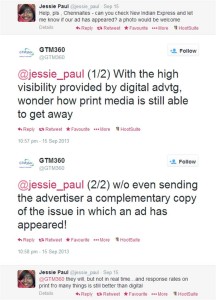Millennials don’t read newspapers and magazines.
That bodes ill for the future of traditional media.
As though such threats caused by generational shifts are not lethal enough, traditional media is hurting itself even further with its lax attitude and casual behavior.
Here are some ways by which traditional media is hurtling towards its downfall.
Can’t Sell
The local distributor of FORTUNE magazine in India is a total joker. I got such an inane response from its Chief Manager – Consumer Marketing Services that I was instantly persuaded that chatbots will replace humans soon. I ditched the distributor and decided to order the subscription directly from the original publisher. I discovered that the Subscribe Now link on its website went to some other website. I tweeted to get the company’s attention. I got no reply.
Hey @FortuneMagazine , did you know that the Subscribe link https://t.co/BwpD2A9PXb at the top RHS of your homepage goes to National Geographic subscription page at https://t.co/LCMyeb2EBZ ? See attached screenshots. #FeatureOrBug? . https://t.co/YFlkIpjvHL
— Ketharaman Swaminathan (@s_ketharaman) January 1, 2019
One more example, this one of a newspaper:
Print may be dying but newspaper publishers are accelerating its demise with high friction subscription ordering journeys. IVR call records my order for a specific @timesofindia Group paper but the person who calls back is clueless about my selection & starts from the beginning.
— Ketharaman Swaminathan (@s_ketharaman) September 3, 2019
Can’t Deliver
Even in the day and age of rising competition from digital ads, newspapers never send you a copy of the issue in which they printed your ad. Ergo it’s not easy to tell whether your print ad has been published at all. As a result, print ads are afflicted with the grave issue of visibility. I first highlighted this problem in 2014 in Don’t Fall For The ‘Invisible Versus Unseen Ads’ Charade. Six years later, I haven’t seen any improvement on this count.
Can’t Drive Repeat Purchase
I recently signed up for a paid subscription to The Wall Street Journal on its website. A few months later, I wanted to cancel it. I couldn’t find the cancel option on the website. After Googling around, I learned that, to cancel, I needed to call a telephone number in Hong Kong, that too, during half of business hours in Hong Kong timezone. I went ahead. I can tell you it was one of the most painful telephone conversations in my life.
After that experience, I decided to never buy a traditional media subscription.
WSJ made me call from Argentina and talk with someone for ten minutes or so just to cancel my digital subscription. I felt stupid for being so naive. Never again.
— Pato Molina (@patriciomolina) January 9, 2020
Can’t Figure Out Which Side Of The Toast Is Buttered
As any brand manager knows, the first page of Google SERP (Search Engine Results Page) is extremely coveted real estate. Brands spend $$$$$ on SEO and SEM to appear there. Likewise Facebook Timeline.
But news outlets in France and Australia have become delusional and are demanding to be paid when their news snippets appear on Google SERPs and Facebook TLs.
Nice try. Tech giants have reacted in the most expected manner.
"We (Facebook) will reluctantly stop allowing publishers and people in Australia from sharing local and international news on Facebook and Instagram."
Again, only the media, govt and regulators think they can force Google/FB's hands.https://t.co/mn6Lw8UhaD
— Shashikant Kore (@kshashi) September 2, 2020
Traditional media has clearly dug its own grave with this one.
The above are doomsday drivers for traditional media on the business side.
Traditional media is hurting itself on the editorial side in many ways such as:
- It does not make any attempt to engage deeply with loyal readers and subscribers
- Many newspapers and magazines have removed their Letters to Editor section
- It rarely responds to missives from readers on Twitter. When business titans, billionaires and celebrities regularly engage with the common man on Twitter and Quora, the radio silence from traditional media is strange.
Traditional media has itself to blame for its downfall.
